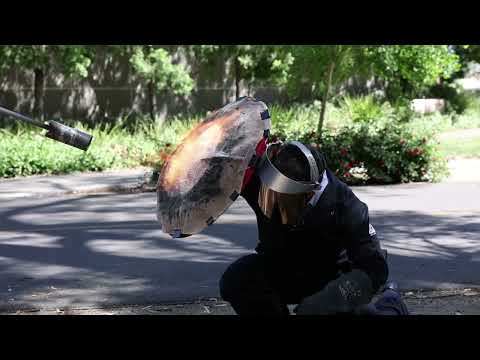Engineers at Switzerland’s École Polytechnique Fédérale de Lausanne (EPFL) have created a system that harnesses audible sound waves to steer objects across an unpredictable aquatic obstacle course. But as neat as it is to watch speakers maneuver a floating ping-pong around a pool, the process known as “wave momentum shaping” may also pave the way for safe, new drug delivery methods inside human patients.
If you have ever attended an extremely loud concert then you know the physical power of soundwaves. To actually push someone around with sound, however, requires volume levels that would injure if not outright kill a person. But while directing a human with audio isn’t a practical method of transportation, the same principles could hypothetically apply to much smaller objects by using more subtle frequencies. Additionally, acoustics’ wide frequency ranges can allow for manipulating targets ranging from centimeters to micrometers in size.

“Sound waves, in particular, offer distinct advantages, as they are biocompatible and harmless and their short wavelengths can penetrate a wide range of heterogeneous, opaque and absorbing media,” EPFL researchers explain in their paper published on June 21 in Nature Physics.
So the engineers did just that, using concepts pioneered by the late Arthur Ashkin’s 2018 Nobel Prize-winning optical tweezers as additional inspiration. But you don’t need to be a world-renowned physicist to understand the team’s wave momentum shaping system—they even go so far as to describe it as “extremely simple” in an accompanying announcement.
“The method is rooted in momentum conservation… and that’s why it’s so promising,” Romain Fleury, study co-author and head of EPFL’s Laboratory of Wave Engineering, said on June 25. While Ashkin’s optical tweezers use laser beams to trap particles, Fleury likens wave momentum shaping to using sound to gently push an object like a hockey stick guiding a puck.
[Related: In the 1960s, swindlers pushed fake radioactive medicine.]
To test their design, researchers placed a ping-pong ball in a large water tank housing multiple speakers positioned throughout the enclosure. They then played 1,590Hz sound waves from the speaker array to glide the ball through a pre-planned path while microphones detected feedback known as a scattering matrix as it bounced off the ball. The scattering matrix data coupled with an overhead camera’s information let the team perform real-time calculations for optimizing sound wave momentum during the ping-pong ball’s journey.
But the engineers weren’t satisfied with only navigating an object through an unchanging environment. Next, they successfully tested their system in a tank that included both fixed and moving obstacles, as well as swapping out the spherical ping-pong ball for more complexly designed objects such as an origami lotus flower. By demonstrating wave momentum shaping’s ability to handle complex, unpredictable environments, the team believes future iterations could handle dynamic spaces like the human body.

“Some drug delivery methods already use soundwaves to release encapsulated drugs, so this technique is especially attractive for pushing a drug directly toward tumor cells, for example,” Fleury said.
Similar methods may also be helpful in other tasks like biological analysis and tissue engineering, when physical interaction might contaminate or damage samples. Going forward, Fleury and colleagues want to move smaller—using ultrasonic waves to guide individual cells.





